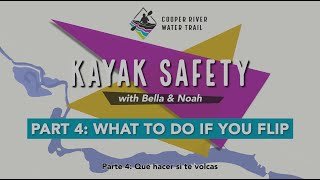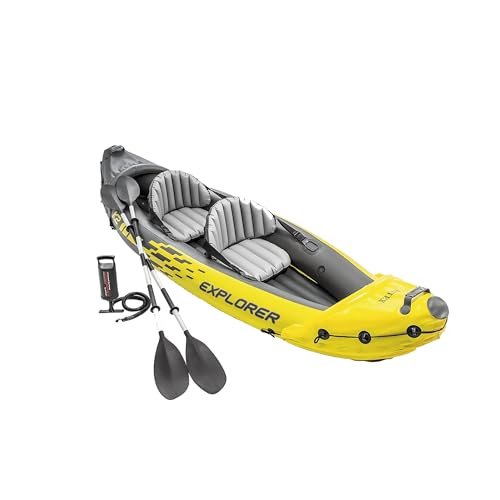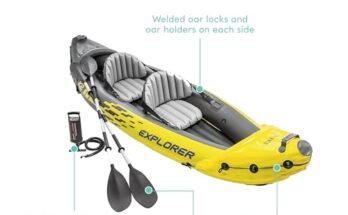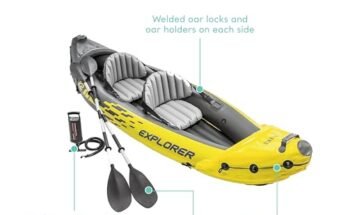What if your kayak flips? It’s a question that might cross your mind when you’re out on the water.
The sudden splash, the rush of cold water, and the panic that can follow—it’s a situation no paddler wants to face. But knowing what to do when your kayak flips can make all the difference. You’ll discover simple steps to stay calm, stay safe, and get back on your kayak quickly.
Keep reading—because being prepared can turn a scary moment into just another part of your adventure.

Causes Of Kayak Flipping
Kayak flipping can happen to anyone on the water. Understanding why it happens helps you avoid it.
Many factors cause a kayak to flip. Some are easy to control, others depend on nature or gear.
Common Mistakes On Water
Many kayak flips happen because of simple mistakes. Losing balance or sudden moves can cause tipping.
Not paying attention or trying risky moves can also make your kayak flip.
- Leaning too far to one side
- Sudden shifts in weight
- Trying to stand or move quickly
- Ignoring safety rules
Weather And Water Conditions
Strong winds and waves make it harder to keep your kayak steady. Rough water can tip you over.
Changing weather can bring unexpected challenges. Cold water and currents increase flipping risks.
- Wind pushing your kayak off balance
- High waves causing instability
- Strong currents pulling you sideways
- Sudden weather changes
Equipment Issues
Faulty or wrong gear can cause your kayak to flip. Poorly fitted equipment affects balance.
Not securing gear properly or using a kayak too small for you also raises risks.
- Worn-out or broken kayak parts
- Improper paddle size or type
- Loose or unbalanced gear inside kayak
- Using a kayak not suited to your weight
Immediate Actions After Flipping
Flipping your kayak can be scary. Knowing what to do right away helps you stay safe.
Follow these steps to regain control and protect yourself in the water.
Stay Calm And Assess
Try to stay calm to think clearly. Take a moment to breathe and look around. Check your surroundings for danger and the kayak’s position.
Hold Onto Your Kayak
Keep a firm grip on your kayak. It helps you stay afloat and makes it easier to get back in. Losing your kayak can be dangerous in open water.
- Grab the kayak’s edge or handles
- Stay close to the kayak at all times
- Avoid letting go unless you are in real danger
Check For Injuries
Look for cuts, bruises, or pain. If you have a serious injury, call for help or signal others. Moving carefully prevents making injuries worse.
| Type of Injury | What to Do |
| Minor Cuts | Rinse with clean water, apply pressure if bleeding |
| Bruises | Rest and avoid putting pressure on the area |
| Severe Pain or Bleeding | Signal for help, keep still, and protect the wound |
Techniques To Right Your Kayak
Flipping your kayak can be scary but knowing how to right it helps you stay safe. There are several ways to handle a flipped kayak. Each method fits different situations and skill levels.
Learning these techniques prepares you for emergencies and builds your confidence on the water. We will cover three common methods to get back in control.
Performing A Wet Exit
A wet exit means leaving your kayak after it flips. This is your first safety skill if you cannot right the kayak quickly. Follow these steps to perform a wet exit safely.
- Hold onto your paddle and kayak firmly.
- Release the spray skirt by pulling the grab loop.
- Lean forward and push your body out of the cockpit.
- Keep your paddle close to avoid losing it in the water.
- Swim to shore or stay near your kayak for rescue.
Using The Eskimo Roll
The Eskimo roll lets you turn your kayak upright without leaving it. This skill requires practice but is very useful in rough water. You use your paddle and body to roll back up.
| Key Action | Description |
|---|---|
| Brace Paddle | Place paddle flat on water to support your roll. |
| Hip Snap | Use your hips to flip the kayak upright quickly. |
| Head Position | Keep your head low and follow it with your body. |
| Practice | Learn in calm water with supervision before trying rough conditions. |
Assisted Rescue Methods
If you cannot right your kayak alone, you may need help. Assisted rescues use another kayaker to help you get back in or flip your kayak upright.
- T-Rescue:Your helper positions their kayak next to yours. They use their paddle to stabilize while you climb back in.
- Hand of God:The helper holds your paddle while you roll up. This method helps if your paddle is lost.
- Tow Assist:The helper pulls your kayak to shore or safer water after rescue.
Essential Safety Gear
Safety gear is very important if your kayak flips. It helps you stay safe and be ready for any emergency.
Knowing what gear to bring can make a big difference in how you handle the situation.
Life Jackets And Pfds
Life jackets and personal flotation devices (PFDs) keep you afloat in the water. Always wear one that fits well and is approved for kayaking.
- Choose a PFD designed for paddling.
- Check straps and zippers before going out.
- Wear it at all times on the water.
- Practice swimming with your PFD on.
Whistles And Signaling Devices
Whistles and other signaling devices help you call for help if you need it. They can be heard from far away and are easy to carry.
| Device | Use | Tip |
| Whistle | Sound alarm | Attach to PFD |
| Signal Mirror | Reflect sunlight | Keep in dry bag |
| Waterproof Flashlight | Night signaling | Check batteries often |
Spray Skirts And Helmets
Spray skirts keep water out of your kayak. Helmets protect your head from rocks and hard surfaces.
Important tips for spray skirts and helmets:
- Make sure the spray skirt fits your kayak and body snugly.
- Choose a helmet made for water sports.
- Practice quick release of your spray skirt in case of emergency.
Preventing Capsizing
Capsizing can be dangerous and scary for kayakers. Knowing how to prevent it keeps you safe on the water. Simple habits help you stay balanced and avoid flipping your kayak.
Use good techniques to keep steady. Learn to read the water and pick safe paths. This lowers the chance of capsizing and makes your trip more fun.
Balancing And Posture Tips
Good balance starts with how you sit in your kayak. Keep your body centered and relaxed. Use your core muscles to stay stable and avoid sudden moves.
- Sit upright with your back straight
- Keep your feet flat against the footrests
- Distribute your weight evenly on both sides
- Hold the paddle firmly but not too tight
- Move smoothly with the water’s flow
Reading Water Currents
Water currents can push your kayak off balance. Watch for ripples, waves, and fast water. Learn to spot safe and risky areas before paddling through.
| Water Condition | What to Do |
| Calm water | Easy to paddle and stable |
| Slow current | Stay alert and maintain control |
| Fast current | Use strong strokes and keep low center |
| Choppy waves | Brace with your paddle and lean into waves |
| Obstacles (rocks, logs) | Avoid or maneuver carefully around them |
Choosing Safe Routes
Pick routes that match your skill level and conditions. Avoid areas with strong currents or hidden dangers. Plan your path to stay safe and steady.
- Check weather and water reports before you go
- Follow marked trails or common kayak paths
- Stay close to shore when unsure
- Tell someone your planned route
- Carry safety gear like a whistle and life jacket

Training And Practice
Kayaking is fun, but safety is important. One key safety aspect is learning what to do if your kayak flips. Training and practice can make you confident and prepared.
Being ready for unexpected situations helps prevent panic. Let’s explore how training and practice can help.
Learning Rescue Skills
Knowing how to rescue yourself is vital. Rescue skills help you return to safety if your kayak flips.
Basic techniques include the wet exit and the Eskimo roll. Practice these often to become comfortable with them.
- Wet exit: Safely exit the kayak when upside down.
- Eskimo roll: Flip the kayak upright without exiting.
Practicing In Controlled Environments
Start practicing rescue skills in safe places. Controlled environments like swimming pools or calm waters are ideal for beginners.
These environments let you focus on learning without strong currents or waves. Practice in different conditions to build confidence.
Joining Kayak Safety Courses
Safety courses offer structured learning. Experienced instructors teach you essential skills for handling a flipped kayak.
Courses often cover rescue techniques, reading water conditions, and equipment use. Group settings also provide support and motivation.
- Learn from professionals
- Hands-on practice
- Meet fellow enthusiasts
Emergency Communication
Kayaking is fun, but safety is key. What if your kayak flips? Being prepared can save your life. Emergency communication is vital.
Knowing how to communicate during an emergency helps you stay safe. You need the right tools and plans before you head out.
Using Waterproof Radios
Waterproof radios can be lifesavers in emergencies. They let you call for help even if you are in the water.
- Ensure the radio is fully charged before your trip.
- Store the radio in a waterproof bag for extra safety.
- Practice using the radio so you are familiar with the controls.
Mobile Phone Safety Tips
Phones are handy for communication, but water can damage them. Here are some tips to keep your phone safe while kayaking.
| Tip | Description |
| Waterproof Case | Use a waterproof case to protect your phone. |
| Battery Life | Keep your phone fully charged before you start. |
| Emergency Contacts | Save important numbers for quick access. |
Informing Others Of Your Plans
Before you go kayaking, tell someone your plans. This step is crucial for your safety and peace of mind.
Share your route and expected return time. This way, if something happens, they can alert authorities promptly.

Frequently Asked Questions
What Should You Do Immediately If Your Kayak Flips?
Stay calm and hold onto your paddle and kayak. Keep your life jacket on. Try to flip the kayak back or swim to shore safely.
How Can You Prevent Your Kayak From Flipping?
Maintain balance by sitting upright and distributing weight evenly. Avoid sudden, sharp movements. Use proper paddling techniques to stay stable.
Is It Safe To Swim After A Kayak Flips?
Yes, if you wear a life jacket. Stay close to your kayak to keep it as a flotation device. Signal for help if needed.
How Do You Perform A Kayak Self-rescue After Flipping?
Flip the kayak upright using your paddle or hands. Use the kayak’s edge to climb back in. Practice self-rescue techniques in calm water.
Conclusion
Kayak flips can feel scary but staying calm helps a lot. Remember to hold onto your paddle and practice how to right your kayak. Wearing a life jacket keeps you safe in the water. Always check the weather and water conditions before you go out.
Knowing what to do makes kayaking safer and more fun. Keep learning and practicing. Enjoy your time on the water with confidence. Safety first, adventure next.



